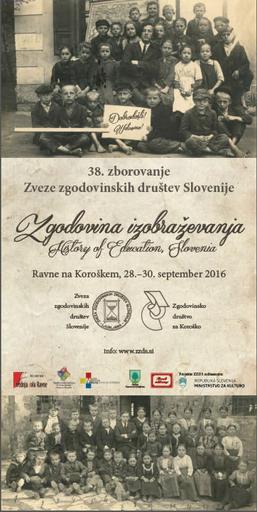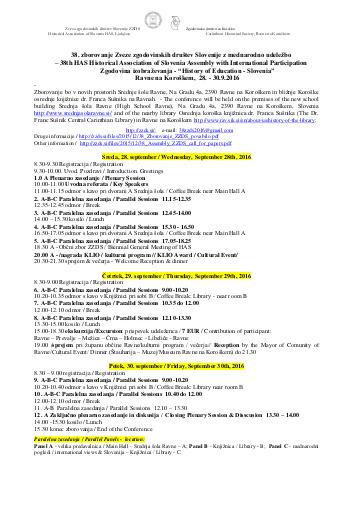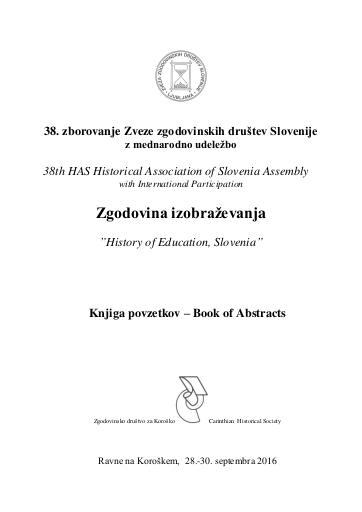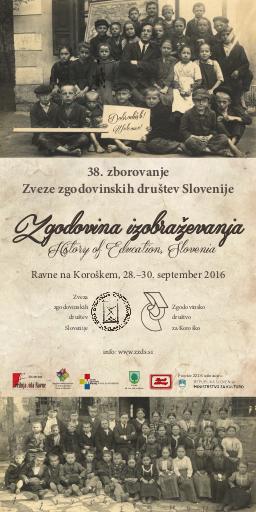/
Dogodki
/
Konference
The Grotesque Discussion About the Destiny of Slovenian Gymnasium of Gorizia, 1919-1922. How to Expel Slovenian Culture From the Cities.

Avtor(ji):Andrea Dessardo
Leto:2016
Založnik(i):Zveza zgodovinskih društev Slovenije, Ljubljana, Inštitut za novejšo zgodovino, Ljubljana
Jezik(i):angleščina
Vrst(e) gradiva:video
Ključne besede:medvojno obdobje, gimnazija, Gorica, Julijska krajina, nacionalizem, interwar period, gymnasium, Gorizia, Julian March, nationalism
Avtorske pravice:

To delo avtorja Andrea Dessardo je ponujeno pod Creative Commons Priznanje avtorstva-Nekomercialno-Brez predelav 4.0 Mednarodna
Datoteke (5)

Ime:program-38-zborovanja-ZZDS.pdf
Velikost:313.04KB
Format:application/pdf
Stalna povezava:https://hdl.handle.net/11686/file22602

Ime:program-38-zborovanja-ZZDS-SLO-ANG.pdf
Velikost:303.57KB
Format:application/pdf
Stalna povezava:https://hdl.handle.net/11686/file22603

Ime:Knjiga-povzetkov–book-of-abstracts.pdf
Velikost:895.33KB
Format:application/pdf
Stalna povezava:https://hdl.handle.net/11686/file22604

Ime:Plakat-38-zborovanja-ZZDS.pdf
Velikost:1.36MB
Format:application/pdf
Stalna povezava:https://hdl.handle.net/11686/file22605
Opis
For the real first time in its history, after World War I, Italy faced the problem how to treat linguistic minorites within its borders. Between the end of the war and the beginning of the Fascist era, the thought about minorities' rights was contradictory and vague. While the official attitude was to be respectful and democratic, in facts Italy gradually limited the public space of its non-Italian new citizens. The case of the Slovenian Gymnasium of Gorizia could be a specimen. The authorities officially claimed the right to mantain non-Italian schools, but only in areas where the minorities traditionally lived. From 1908 existed in Gorizia a Slovenian Gymnasium, never tolerated by Italian nationalists. After World War I it was closed and then temporally re-opened in the same building of the Slovenian Realschule in Idrija. The issue was to set Slovenian schools only in pure Slovenian towns, in which there were no Italians: since all the bigger towns in the Julian March had Italian majorities (Trieste, Gorizia, Capodistria…), Slovenian schools should be set only in small and marginal towns like Idrija and Tolmin. From 1919 to 1921 Italian politicians and intellectuals discussed in private letters and in the newspapers about where to transfer the Slovenian Gymnasium: to Ajdovščina, to Postojna or to Sežana, even to Vipava… But somebody also suggested to set it in pure Italian areas, far from the influence of potential Slovenian irredentism, like Udine or Cividale. The beginning of Fascist era finally decided the definitive closure of all non-Italian schools.
Metapodatki (11)
- identifikatorhttps://hdl.handle.net/11686/37368
- naslov
- The Grotesque Discussion About the Destiny of Slovenian Gymnasium of Gorizia, 1919-1922. How to Expel Slovenian Culture From the Cities.
- avtor
- Andrea Dessardo
- predmet
- medvojno obdobje
- gimnazija
- Gorica
- Julijska krajina
- nacionalizem
- interwar period
- gymnasium
- Gorizia
- Julian March
- nationalism
- opis
- For the real first time in its history, after World War I, Italy faced the problem how to treat linguistic minorites within its borders. Between the end of the war and the beginning of the Fascist era, the thought about minorities' rights was contradictory and vague. While the official attitude was to be respectful and democratic, in facts Italy gradually limited the public space of its non-Italian new citizens. The case of the Slovenian Gymnasium of Gorizia could be a specimen. The authorities officially claimed the right to mantain non-Italian schools, but only in areas where the minorities traditionally lived. From 1908 existed in Gorizia a Slovenian Gymnasium, never tolerated by Italian nationalists. After World War I it was closed and then temporally re-opened in the same building of the Slovenian Realschule in Idrija. The issue was to set Slovenian schools only in pure Slovenian towns, in which there were no Italians: since all the bigger towns in the Julian March had Italian majorities (Trieste, Gorizia, Capodistria…), Slovenian schools should be set only in small and marginal towns like Idrija and Tolmin. From 1919 to 1921 Italian politicians and intellectuals discussed in private letters and in the newspapers about where to transfer the Slovenian Gymnasium: to Ajdovščina, to Postojna or to Sežana, even to Vipava… But somebody also suggested to set it in pure Italian areas, far from the influence of potential Slovenian irredentism, like Udine or Cividale. The beginning of Fascist era finally decided the definitive closure of all non-Italian schools.
- založnik
- Zveza zgodovinskih društev Slovenije
- Inštitut za novejšo zgodovino
- datum
- 2016
- 28. 09. 2016
- tip
- video
- jezik
- Angleščina
- jeDelOd
- pravice
- licenca: ccByNcNd
